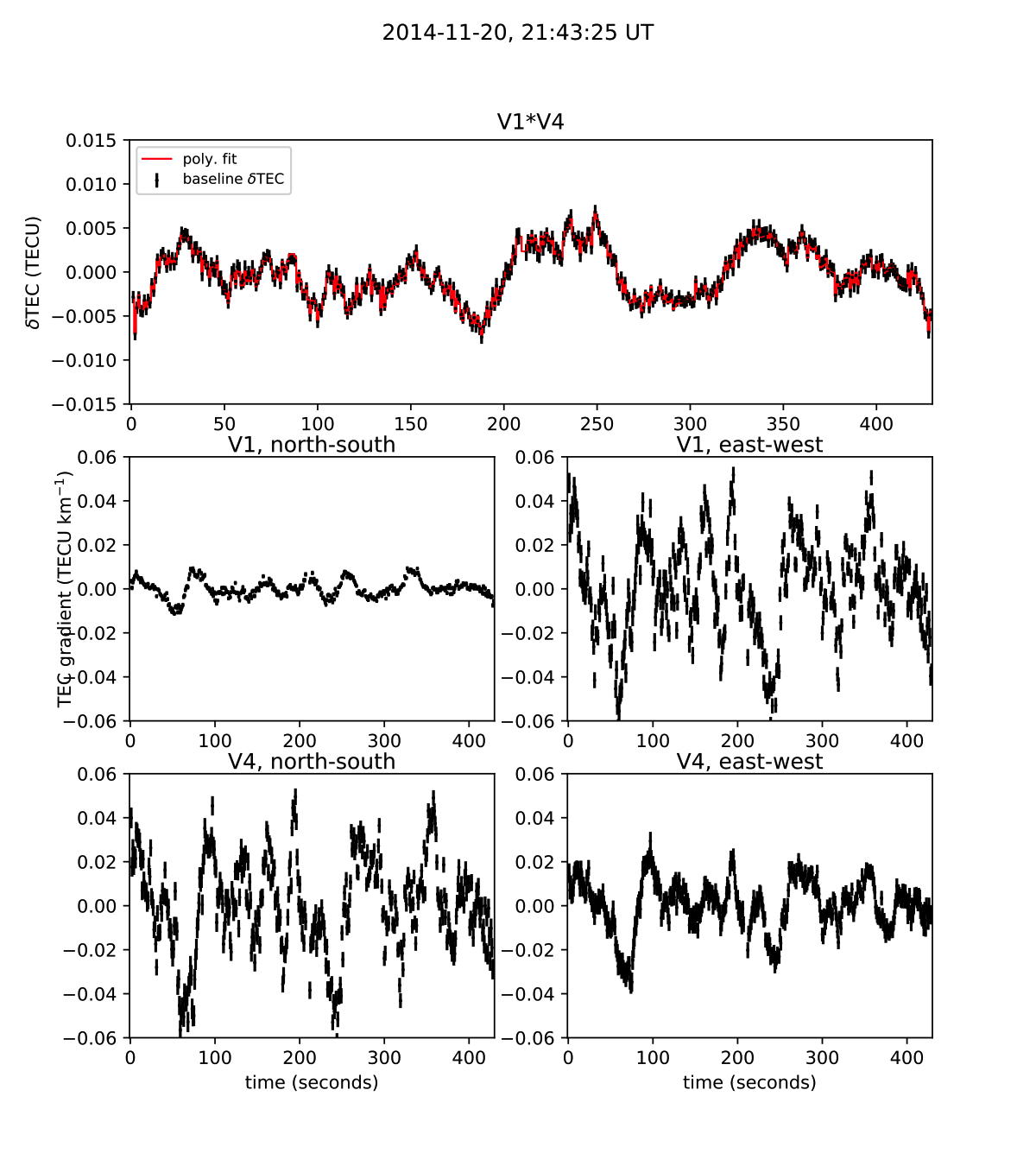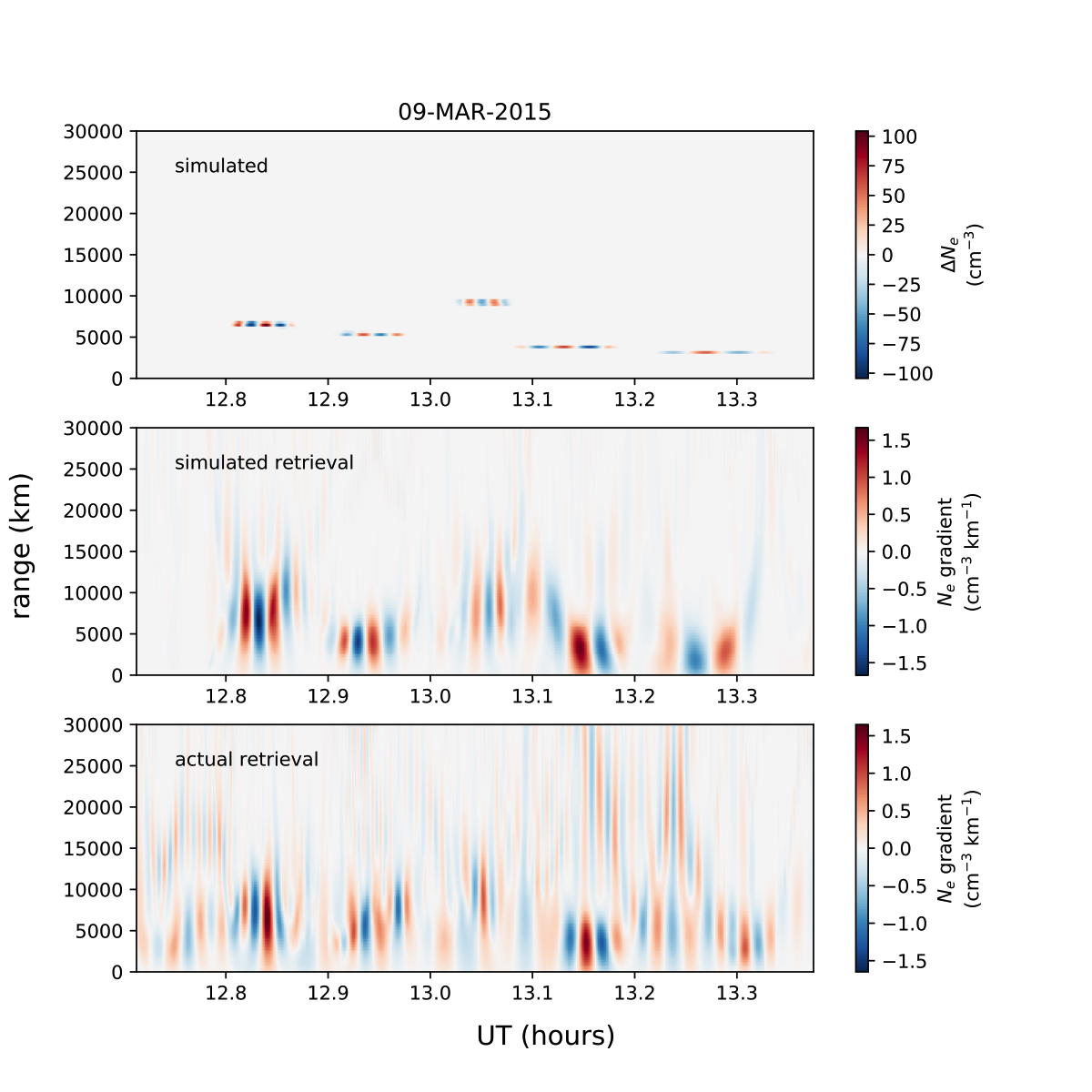
|
VLA Low-band Ionosphere and Transient Experiment (VLITE)Ionosphere |

|
Ionospheric Analysis
The ionosphere analysis portion of VLITE is dedicated to the study of fine-scale (~1-10 km)
ionosphere dynamics and the relationship to larger structures (hundreds of km). The VLA
low-band systems have virtually unmatched sensitivity to fluctuations in the ionosphere
total electron content (TEC), the integrated density of free electrons along a line of
sight. When observing a bright cosmic source, these systems can be used to characterize TEC
fluctuations more than two orders of magnitude weaker than those detectable with similar
GPS-based methods. Such fluctuations are prevalent on smaller scales, making the VLA an
excellent instrument for probing fine-scale ionosphere dynamics. Many continuously operating
GPS receivers within New Mexico are also being used to simultaneously study larger-scale
fluctuations. The (nearly) continuous data stream delivered by VLITE, when combined with
this GPS data, constitutes a singular data set for the study of coupling mechanisms among
fine-, medium-, and large-scale ionosphere dynamics. In addition, such a continuous flow of
data allows for the characterization of the fine-scale ionosphere response to relatively
rare space weather, atmospheric, and/or seismic events such as solar flares
(Helmboldt et al. 2015), large storms,
earthquakes, and explosions (Huang et al.
2019) that would be missed by proposal-based, low-band observing.

The ionosphere pipeline is optimized to sense fluctuations on small temporal (~seconds), spatial (~few km), and amplitude (~10-3-10-4 TECU km-1) scales. Because the δTEC values represent antenna-based effects that dominate on short time scales (~minutes or less), the general approach to signal processing is as follows:
- Extract good visibility phases from the raw data, while flagging obviously aberrant data.
- Unwrap the phase time series and de-trend to remove slowly varying instrumental and/or source contributions.
- Determine and remove contributions from baseline-based errors.
- Use final δTEC time series to compute TEC gradients.
Plasmaspheric Analysis
Between the ionosphere and the solar wind-driven outer magnetosphere is a region of
relatively cold, co-rotating plasma known as the plasmasphere. Magnetic field-aligned
irregularities with longitudinal scales of tens of km were discovered with the VLA low-band
system in the early 1990s
( Jacobson & Erickson 1992).
These were first identified as relatively fast moving/oscillating waves directed toward
magnetic east until it was realized that the high speed was due to co-rotation at a
relatively large distance (thousands of km). Using archival VLA low-band data and VLITE
data, a method was recently developed to produce range/time-resolved images of these
structures, sometimes called co-rotating plasmaspheric irregularities (CPIs;
Helmboldt et al. 2020). This method
spectrally decomposes the time series of TEC gradients measured using the methods described
above into several frequency bands. A phase velocity is then estimated for each of the
higher-frequency oscillation bands most likely to be CPIs. Because their motions are
dominated by co-rotation, the magnitude of this velocity gives the distance to the
disturbance. A check is made to confirm that the velocity direction is consistent with what
is expected for a CPI. Following this, the data from all bands are recombined to form a
range/time image (see an example below). A separate pipeline runs daily to identify any
observations of bright calibrators longer than five minutes in duration and performs this
imaging analysis on those data.

Modified on Friday, 02-Jun-2023 11:04:50 MDT
